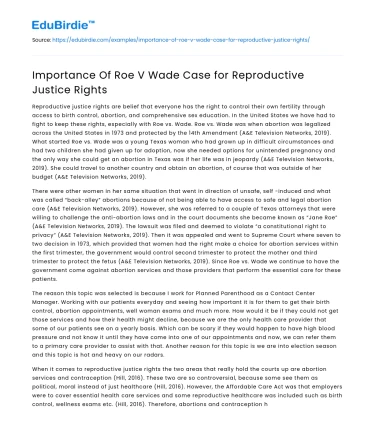Reproductive justice rights are belief that everyone has the right to control their own fertility through access to birth control, abortion, and comprehensive sex education. In the United States we have had to fight to keep these rights, especially with Roe vs. Wade. Roe vs. Wade was when abortion was legalized across the United States in 1973 and protected by the 14th Amendment (A&E Television Networks, 2019). What started Roe vs. Wade was a young Texas woman who had grown up in difficult circumstances and had two children she had given up for adoption, now she needed options for unintended pregnancy and the only way she could get an abortion in Texas was if her life was in jeopardy (A&E Television Networks, 2019). She could travel to another country and obtain an abortion, of course that was outside of her budget (A&E Television Networks, 2019).
There were other women in her same situation that went in direction of unsafe, self -induced and what was called “back-alley” abortions because of not being able to have access to safe and legal abortion care (A&E Television Networks, 2019). However, she was referred to a couple of Texas attorneys that were willing to challenge the anti-abortion laws and in the court documents she became known as “Jane Roe” (A&E Television Networks, 2019). The lawsuit was filed and deemed to violate “a constitutional right to privacy” (A&E Television Networks, 2019). Then it was appealed and went to Supreme Court where seven to two decision in 1973, which provided that women had the right make a choice for abortion services within the first trimester, the government would control second trimester to protect the mother and third trimester to protect the fetus (A&E Television Networks, 2019). Since Roe vs. Wade we continue to have the government come against abortion services and those providers that perform the essential care for these patients.
Save your time!
We can take care of your essay
- Proper editing and formatting
- Free revision, title page, and bibliography
- Flexible prices and money-back guarantee
The reason this topic was selected is because I work for Planned Parenthood as a Contact Center Manager. Working with our patients everyday and seeing how important it is for them to get their birth control, abortion appointments, well woman exams and much more. How would it be if they could not get those services and how their health might decline, because we are the only health care provider that some of our patients see on a yearly basis. Which can be scary if they would happen to have high blood pressure and not know it until they have come into one of our appointments and now, we can refer them to a primary care provider to assist with that. Another reason for this topic is we are into election season and this topic is hot and heavy on our radars.
When it comes to reproductive justice rights the two areas that really hold the courts up are abortion services and contraception (Hill, 2016). These two are so controversial, because some see them as political, moral instead of just healthcare (Hill, 2016). However, the Affordable Care Act was that employers were to cover essential health care services and some reproductive healthcare was included such as birth control, wellness exams etc. (Hill, 2016). Therefore, abortions and contraception has been looked at as more of “non-essential”, “therapeutic”, or “elective” (Hill, 2016). There were ways that employers could avoid providing contraception for their employees by claims of religious exemptions, an example which was Burwell v. Hobby Lobby (Hill, 2016).
The Trump Administration around August 2019 made it to where if an organization provides abortion care or refers patients for abortion care they are unable to receive federal funding from Title X. This is information that patients need to help them make good decisions about their care, their body, and their families. A doctor or any healthcare provider does not just come out and refer someone for abortion services, they ask what their plans are are moving forward with the information they have just received. If they are planning on parenting and carrying their pregnancy to term, wonderful then there are referrals given for that and any choice that is made otherwise that’s a different referral. Patients want to get correct information about their care and what options they have. Planned Parenthood did not continue to accept federal funds, because they decided they were not going to comply with the Trump Administration restrictions to not refer patients to get and provide abortion care. Dr. Wen in this article talks about when Planned Parenthood was going through the process of getting court decisions and before the ruling happened to stop the Trump Administration and then when the Supreme Court Ruling happened (Abbasi, 2019). Overall, there is a fight for reproductive justice rights in the United States and the lawsuits have been filed under the violation of the first amendment and the 14th amendments.
The law is the First Amendment, which protects the freedom of speech, religion, and the press. (A&E Television Networks, 2019). When dealing with reproductive health care the court system struggle and highly divided on constitutional rights (Hill, 2016). This is not a black or white subject and sometimes these get passed up because they are not seen as healthcare (Hill, 2016). Abortion and contraception are seen by the court system as something other than healthcare because of targeted laws and regulations (Hill, 2016).
References
- A&E Television Networks. (2019, September 25). First Amendment. Retrieved from History: https://www.history.com/topics/united-states-constitution/first-amendment
- A&E Television Networks. (2019, 05 15). Roe v. Wade. Retrieved from History: https://www.history.com/topics/womens-rights/roe-v-wade
- Abbasi, J. (2019). New Planned Parenthood President: No Politics in the Exam Room. Journal of the American Medical Association, 3.
- Hill, B. J. (2016). The First Amendment and the Politics of Reproductive Health Care. Washington University Journal of Law & Policy, 43.






 Stuck on your essay?
Stuck on your essay?

